Since the eyelids of birds aren’t used in blinking we don’t get to see them very often.
In birds the eye is lubricated by the translucent nictitating membrane, sometimes called the third eyelid, that sweeps horizontally across the eye so their true eyelids usually remain open and unseen. When they’re sleeping the lower eyelid rises to cover the eye in most birds, with the exception of the horned owls whose upper eyelid is lowered.
Usually, when they’re performing activities that could potentially injure their eye, it’s their nictitating membrane that is temporarily closed but they’re capable of raising their lower eyelid instead. When that happens it can be disconcerting to the observer because it looks so unusual and we’re not used to seeing it.
But this Swainson’s Hawk gave me a good, long look at ‘his’ closed lower eyelid.
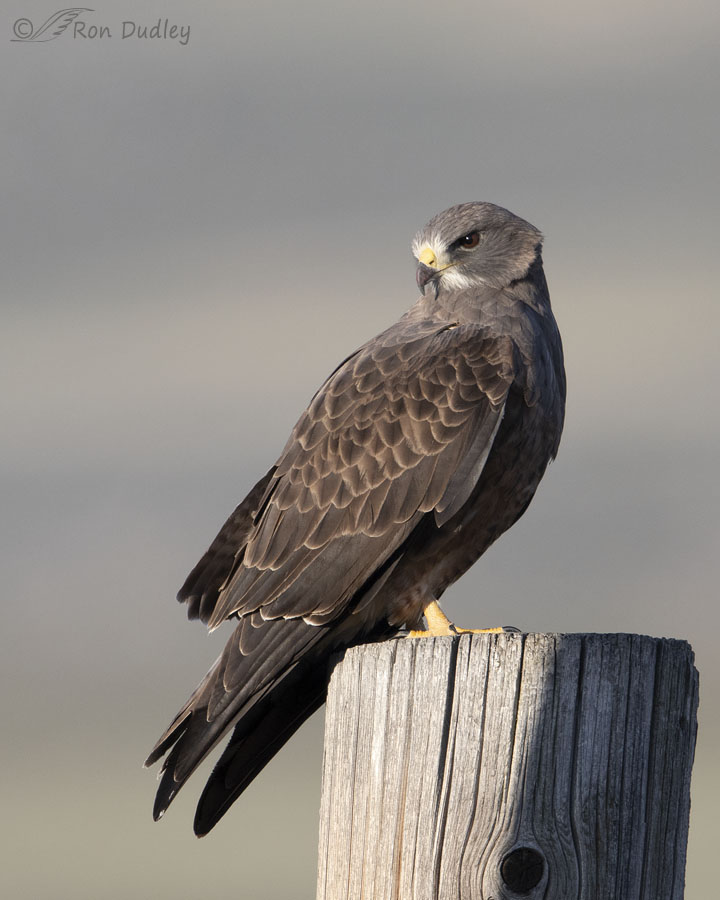
I spent a lot of time with him on three different perches but he was nearly always facing to my right so I seldom got a good look at his left eye. I’m only including this photo because his head turn allows us to see his left eye and determine that it’s ‘normal’ and almost certainly uninjured.
Soon after this photo was taken he…
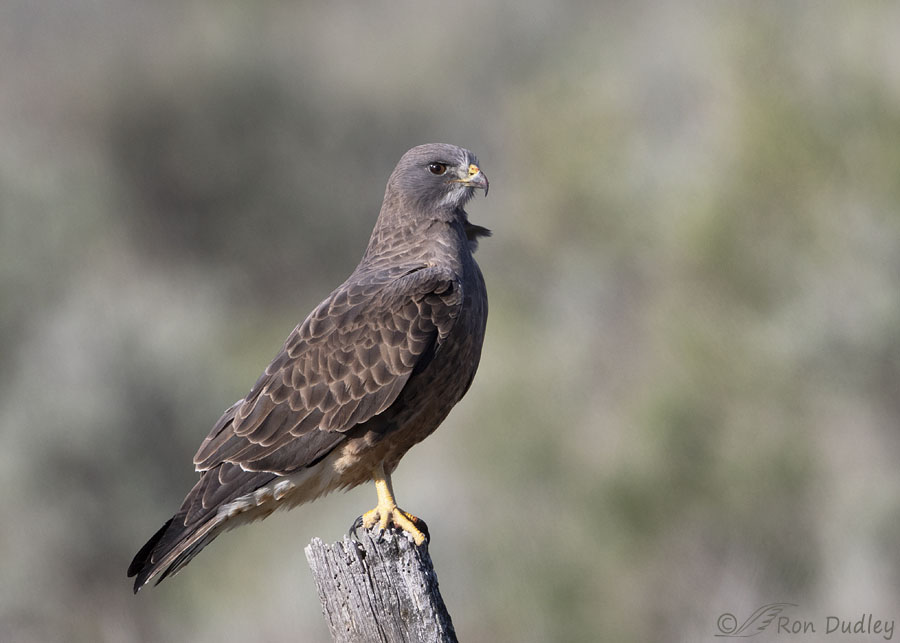
flew to another fence post because a passing truck scared him off his previous perch. After he relaxed again he…
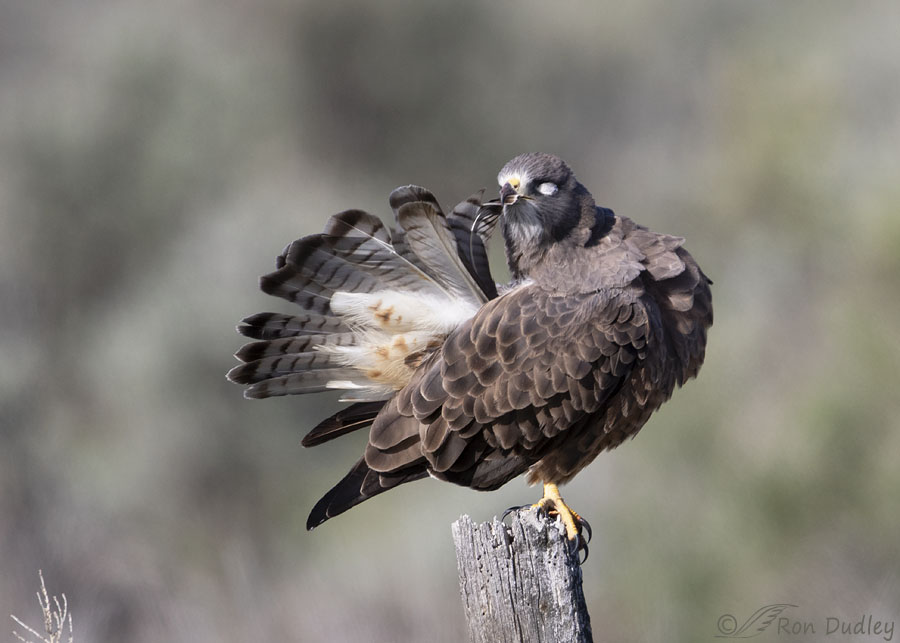
began to preen his tail feathers and as he did so he raised his lower eyelid instead of closing his nictitating membrane as they usually do to protect their eye.
It looks pretty weird doesn’t it.
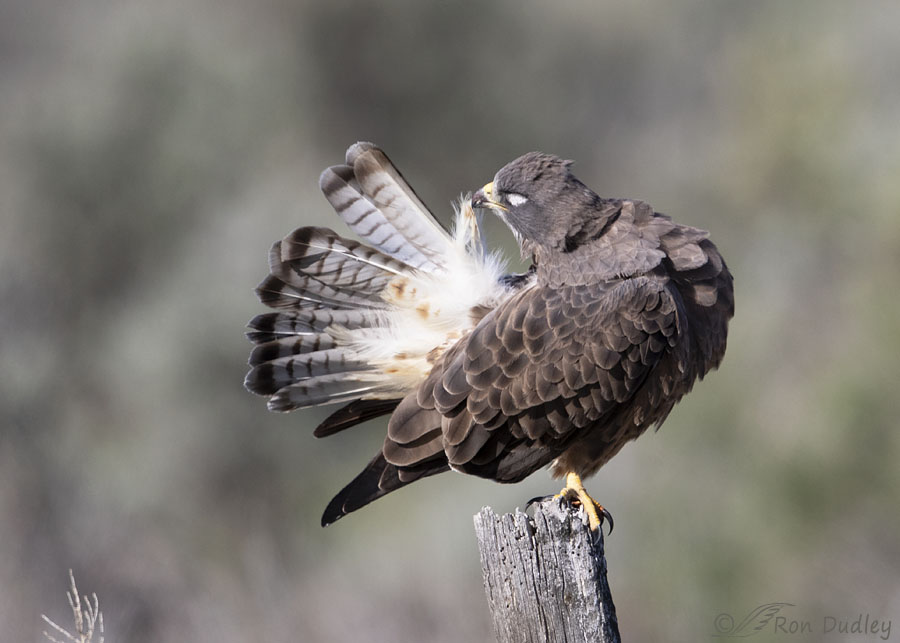
As he preened his tail feathers he kept it closed long enough for me to get quite a few photos of it.
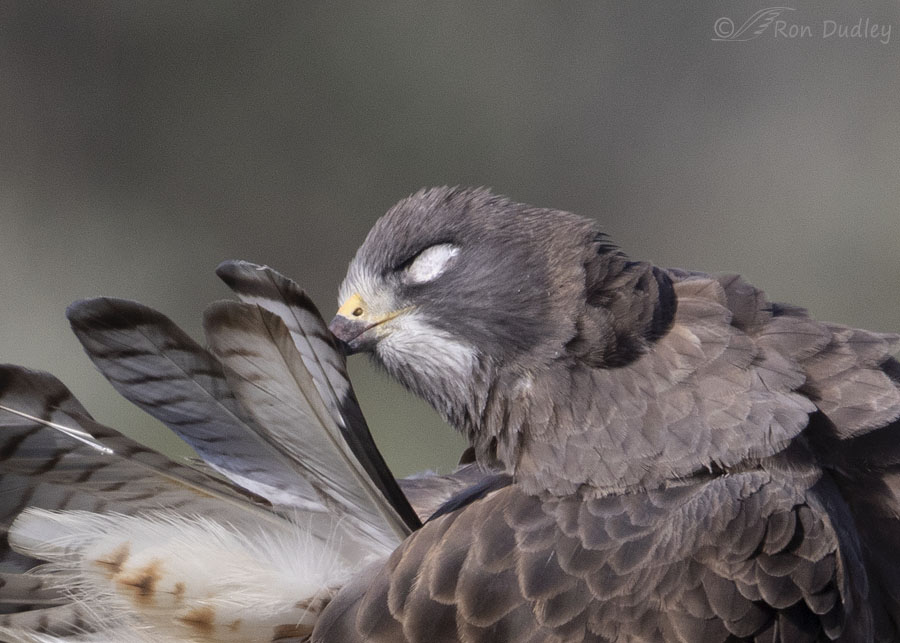
The outside of the eyelid is covered with tiny feathers, white feathers in the case of Swainson’s Hawks, so when the eyelid is closed it really stands out.
Most often I see the lower eyelid closed when that eye is injured but I’m almost certain that his eye wasn’t injured. For some reason he just chose to close it, instead of his nictitating membrane, while preening.
Whatever his motivation I thought it was interesting to see, especially for so long.
Ron
Note: The colors of the hawk in the first photo look richer than the colors in the rest of the photos because the first photo was taken with a different camera and lens and the light was different while the bird was on one perch compared to the other.


Extremely interesting. Good work in sticking around to document that.
Ron, ditto on the comments from before! The photos are spectacular fo this gorgeous bird and the information was fantastic. I have seen Dipper nictitating eyelids as they are waking into the water and hunting insects on the bottom-so they must be able to see through them! They are very white too. But I have never seen that lower eyelid on any hawks or other birds and will be keeping my eyes open for it. Thanks so much for the information.
He’s winkin’ atcha (while shaking his tail feathers). 😉 Fabulous shots of something we rarely — if ever — get to see!
Thank you, Marty.
How fascinating.
Those teeny weeny feathers must be incredibly soft…
Thank you so much for continuing my education.
Thanks, EC.
Just learned something (as usual when I read your posts). Now I know why the eyes of several newly hatched ducklings all turned dead white when they all fell asleep at the same time.
Yup, that’s why, Kenneth.
Super-interesting post today, Ron. What a gorgeous bird! Wow!
And love all the comments from your followers – what a knowledgeable group of people you have gathered. It’s like first period biology class every morning!
“It’s like first period biology class every morning!”
Man, did that ever bring back memories, Carolyn – given the fact that I was a biology teacher for 33 years.
Well, you got me thinking and I realized that I really didn’t understand why it was called a third eyelid. A quick search made it clear that most birds close their eyes with the bottom eyelid with the exception of owls. In either case, I’ve only seen the one eyelid move. I think I might have seen both eyelids but only with sick birds. And I certainly didn’t know abut the feathered eyelid.
Lyle, I should have mentioned sick birds in my post, not just those with injured eyes.
So interesting, all those tiny feathers! I have occasionally seen the nictitating membrane on birds at the raptor center and on some web cams I watch, but I hadn’t really thought much about their regular eyelids. I captured a web cam image several years ago of a peregrine with what I now believe is her closed eyelid; I was sure it wasn’t the NM, but at the time I did wonder if her eye was injured. Beautiful Swainson’s here, BTW—thanks for the photos and lesson!
I keep wondering about “all those tiny feathers” too, Chris. On a structure like an eyelid I assume they must be incredibly soft and flexible.
Interesting! From a distance one would think that eye had an injury. Porcupine’s comments on using the 3rd eyelid as a sun filter is also something I didn’t know or wouldn’t have occurred to me. Continuing education as always…… 🙂
Thank you, Judy.
Very interesting. Wonderful insightful photos. Thank you Ron.
Thanks, Linda.
That is really interesting Ron. Don’t think I have ever seen the actual true eyelid closed. He’s the Swainson’s Ghost from an Edgar Allen Poe story. Like Pat G. I have always been aware of the nictitating membrane, but was not aware of the true eyelid.
Thank you, Everett.
Some animals can see through the nictitans, the Hyrax is a good example. They can close their nictitans and look directly at the sun and see an eagle coming at them from what would otherwise be a blind spot created by the sun and exploited by the eagle. Interesting to ponder whether some birds can also see through the third eyelid. Surely some ornithologist has investigated this question?
Perhaps this bird had an injury to the nictitans, forcing him to use the full lid. Impossible to tell without a close exam so we can theorize to our heart’s desire!
Impressive bird and nice photos.
Porcupine, many birds can see, to a greater or lesser degree, through their membranes. The membrane is translucent to transparent. For example, diving birds like loons, auks and and diving ducks keep their membranes closed while diving and looking for food.
Wow! I’ve known about the nictating membrane for a long time but never knew there was a lower eyelid that could be raised and one with feathers on it! Once again, thanks for great photos and a fascinating bit of anatomy and behaviour.
Thanks, Pat. That’s why the nictitating membrane is often called the “third eyelid”.
It’s especially interesting to me that the lower eyelid is ” covered with tiny
feathers “, which I guess would offer an extra degree of cushioning and
protection– super spooky-looking ! Fascinating info, every day– thanks !
Thanks, Kris. Yes, when that lower eyelid is closed it often causes a classic double take from the observer. It isn’t what we expect to see.
I’ve noticed that in waterfowl at least, the “true” eyelid is a contrasting color to the area around it. So from a distance you might not be able to easily distinguish it from an open eye. I’m thinking this may have some evolutionary value to the duck in not “giving away” to predators that they are more vulnerable in not being able to see at that moment.
Interesting possibility, David. Makes sense to me.